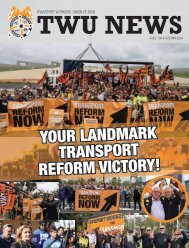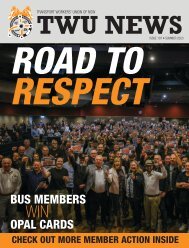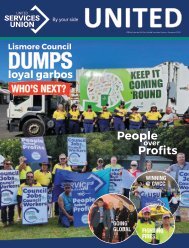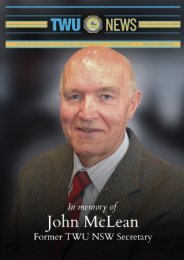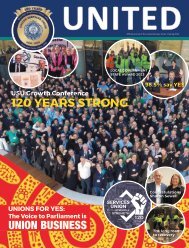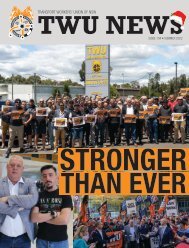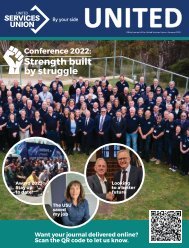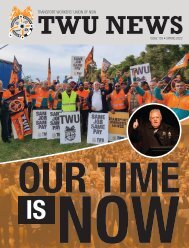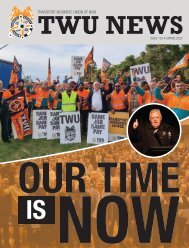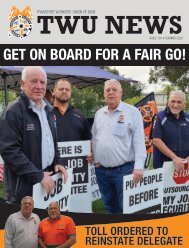The Birth of an Organising Union
Celebrating 125 years of organising transport workers in New South Wales
Celebrating 125 years of organising transport workers in New South Wales
You also want an ePaper? Increase the reach of your titles
YUMPU automatically turns print PDFs into web optimized ePapers that Google loves.
On Saturday 2 February 1901, a<br />
meeting <strong>of</strong> trollymen, draymen, <strong>an</strong>d<br />
carters was held at the Trades Hall in<br />
Sussex Street, Sydney, ‘with the object<br />
<strong>of</strong> establishing a union’.<br />
<strong>The</strong> attend<strong>an</strong>ce was, according to a<br />
newspaper report, ‘exceptionally large’.<br />
Forming a union <strong>of</strong> drivers <strong>of</strong> ‘Sydney<br />
<strong>an</strong>d the suburbs’ was <strong>an</strong> idea whose<br />
time had come. Over 500 drivers<br />
signed up to join the new union.<br />
<strong>The</strong> meeting was chaired by William<br />
Morris Hughes, the energetic <strong>an</strong>d<br />
ambitious Labor member <strong>of</strong> the New<br />
South Wales Parliament. Hughes<br />
represented the seat <strong>of</strong> L<strong>an</strong>g, which<br />
covered the working class districts<br />
around western Sydney harbour, where<br />
m<strong>an</strong>y <strong>of</strong> the union’s members lived <strong>an</strong>d<br />
worked.<br />
Hughes observed that ‘during the past<br />
few months Australia had experienced<br />
unprecedented activity in labour<br />
circles’, <strong>an</strong>d he added that ‘such <strong>an</strong><br />
enthusiastic response as the men had<br />
made was very flattering to those who<br />
set the movement for a union on foot.’<br />
<strong>The</strong> assembled men flattered<br />
themselves by putting their faith in<br />
one <strong>an</strong>other. <strong>The</strong>y voted to establish<br />
‘a temporary m<strong>an</strong>agement committee,<br />
consisting <strong>of</strong> one representative from<br />
each yard’, who would ‘carrying on the<br />
initial business <strong>of</strong> the union.’<br />
It was also decided that ‘for the first<br />
three months <strong>of</strong> the union’s existence<br />
no <strong>of</strong>ficers should be paid. <strong>The</strong><br />
entr<strong>an</strong>ce fee for joining the union was<br />
to be one shilling, <strong>an</strong>d the subscription<br />
for membership was set at six pence<br />
per week for the first three months.<br />
<strong>The</strong> Trolly, Draymen <strong>an</strong>d Carters’<br />
<strong>Union</strong> would be firmly based in<br />
the org<strong>an</strong>isation <strong>of</strong> its r<strong>an</strong>k <strong>an</strong>d<br />
file members, supported by the<br />
broader labour movement, including<br />
the members <strong>of</strong> Parliament who<br />
encouraged the union’s formation.<br />
‘A union among the class <strong>of</strong> workers<br />
4 <strong>The</strong> <strong>Birth</strong> <strong>of</strong> <strong>an</strong> Org<strong>an</strong>ising <strong>Union</strong>




